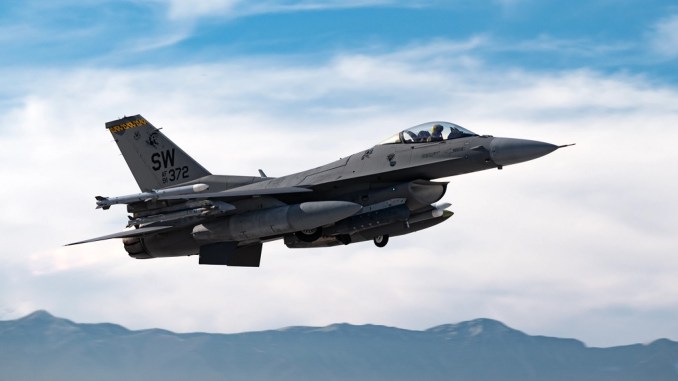
The upgraded Litening pod incorporates significant enhancements in electro-optical/infrared sensing and processing capabilities.
Northrop Grumman disclosed recently that the U.S. Air Force is currently fielding the upgraded Litening Large Aperture targeting pod, which incorporates significant enhancements in electro-optical/infrared sensing and processing capabilities compared to the older variant. The news follows the recent frequent sightings of Litening pods on active-duty F-16s instead of the Sniper pod.
In fact, while the AAQ-28 Litening targeting pod was previously fielded across all units, USAFE, PACAF and ACC units replaced it with the newer Lockheed Martin AAQ-33 Sniper targeting pod, while the Litening remained in use by ANG units. Since late 2023, however, many photos surfaced online both from the Air Force and aircraft spotters showed a new return of the Litening on USAFE, PACAF and ACC F-16s.
Northrop Grumman listed in its press release the three main features of Litening Large Aperture:
- Digital, high-definition daylight and infrared sensors in multiple wavelengths increase the resolution of the pod, allowing imaging from greater stand-off ranges.
- LITENING LA features faster video processing, greater image stabilization, enhanced pod command and control functions, and continuous roll for uninterrupted imaging during maneuvers
- Enhanced air and ground targeting modes offer greater accuracy and tracking under challenging conditions.
The Air Force first selected Litening in 1999, before selecting also the Sniper pod in 2001 and adopting both. The service now plans to integrate Litening LA throughout its existing aircraft inventory. In fact, since the new pod uses the same form factor as earlier versions and aircraft on which it has already been integrated do not require further modifications, the pods already in inventory can be upgraded to the LA configuration.
LITENING Large Aperture features new sensors and software which increase image resolution and target identification capabilities from stand-off ranges. (Photo Credit: Northrop Grumman)
” data-medium-file=”https://i0.wp.com/theaviationist.com/wp-content/uploads/2024/03/Litening_Large_Aperture_USAF.jpg?fit=460%2C289&ssl=1″ data-large-file=”https://i0.wp.com/theaviationist.com/wp-content/uploads/2024/03/Litening_Large_Aperture_USAF.jpg?fit=706%2C443&ssl=1″ decoding=”async” class=”size-large wp-image-84994″ src=”https://zephyrnet.com/wp-content/uploads/2024/03/u-s-air-force-upgrading-litening-targeting-pods-to-new-large-aperture-variant-1.jpg” alt width=”706″ height=”443″ srcset=”https://zephyrnet.com/wp-content/uploads/2024/03/u-s-air-force-upgrading-litening-targeting-pods-to-new-large-aperture-variant-1.jpg 706w, https://zephyrnet.com/wp-content/uploads/2024/03/u-s-air-force-upgrading-litening-targeting-pods-to-new-large-aperture-variant-2.jpg 460w, https://zephyrnet.com/wp-content/uploads/2024/03/u-s-air-force-upgrading-litening-targeting-pods-to-new-large-aperture-variant-3.jpg 128w, https://zephyrnet.com/wp-content/uploads/2024/03/u-s-air-force-upgrading-litening-targeting-pods-to-new-large-aperture-variant-4.jpg 768w, https://i0.wp.com/theaviationist.com/wp-content/uploads/2024/03/Litening_Large_Aperture_USAF.jpg?w=1024&ssl=1 1024w” sizes=”(max-width: 706px) 100vw, 706px” data-recalc-dims=”1″>
“Just as the first LITENING targeting pod transformed close air support more than 20 years ago, LA’s passive targeting capabilities have the potential to change the way pilots approach combat in high-intensity conflicts,” said James Conroy, vice president, electronic warfare and targeting, Northrop Grumman. “We are widening the aperture on how electro-optical/infrared targeting can contribute to mission success, with a more advanced and powerful pod.”
The pod enables a wide range of missions, including precision targeting, Close Air Support, Non-Traditional Intelligence, Surveillance and Reconnaissance (NTISR), Strike Coordination and Reconnaissance (SCAR), but also air-to-air identification. The pod features high-resolution, digital color video and infrared sensors, datalink capability and advanced algorithms to detect, identify and engage targets from long ranges. A more powerful mission processor accelerates imaging functions and allows for future capabilities, says Northrop Grumman, including artificial intelligence and machine learning.
- SEO Powered Content & PR Distribution. Get Amplified Today.
- PlatoData.Network Vertical Generative Ai. Empower Yourself. Access Here.
- PlatoAiStream. Web3 Intelligence. Knowledge Amplified. Access Here.
- PlatoESG. Carbon, CleanTech, Energy, Environment, Solar, Waste Management. Access Here.
- PlatoHealth. Biotech and Clinical Trials Intelligence. Access Here.
- Source: https://theaviationist.com/2024/03/11/usaf-upgrades-litening-pods/?utm_source=rss&utm_medium=rss&utm_campaign=usaf-upgrades-litening-pods




